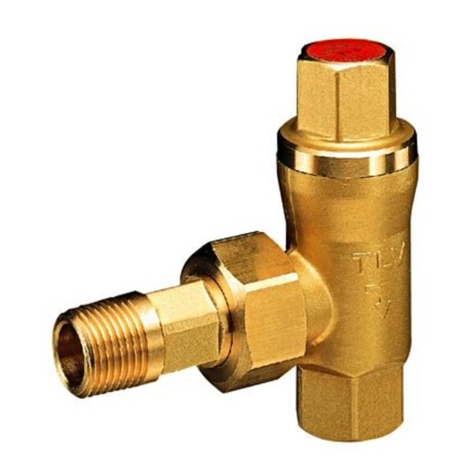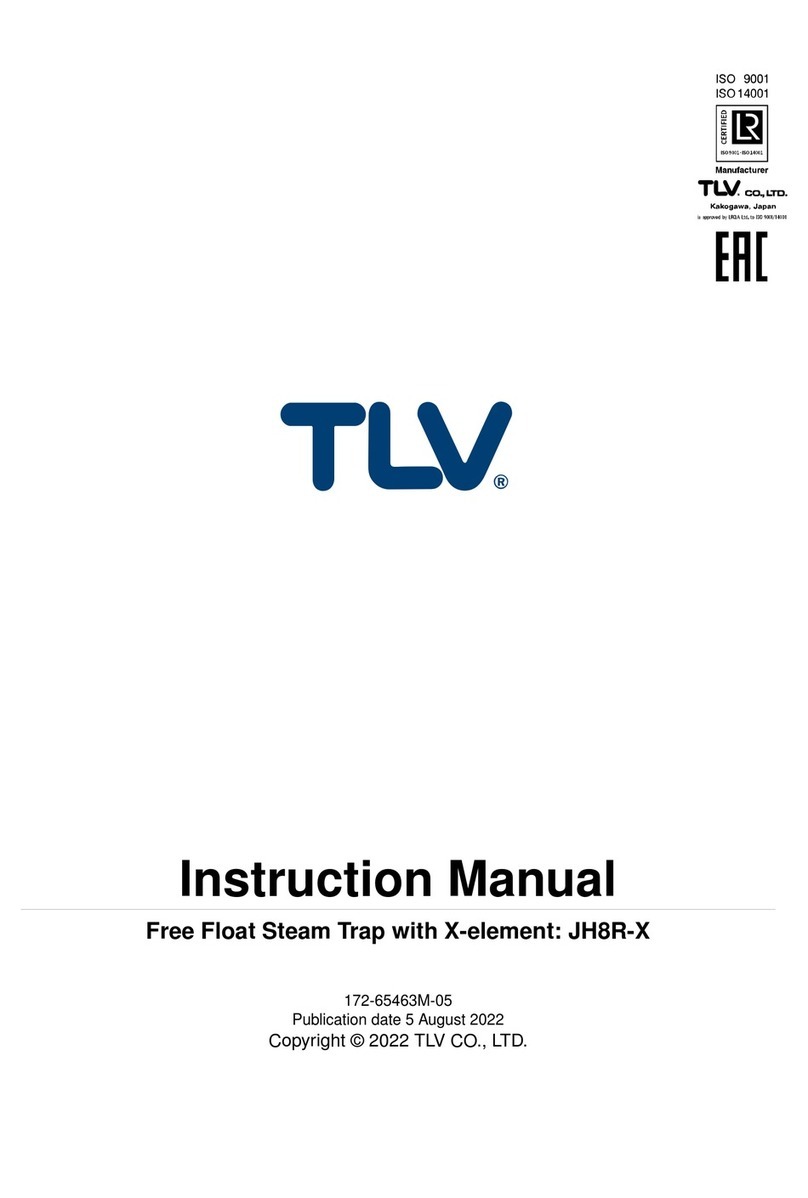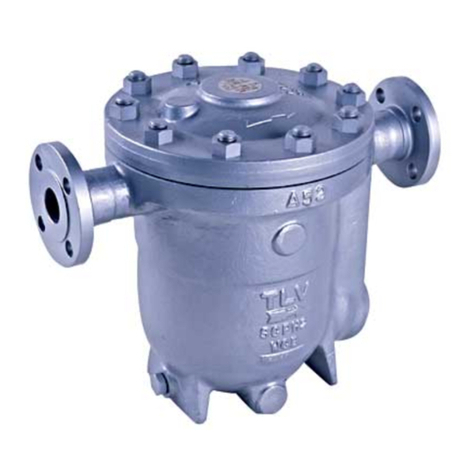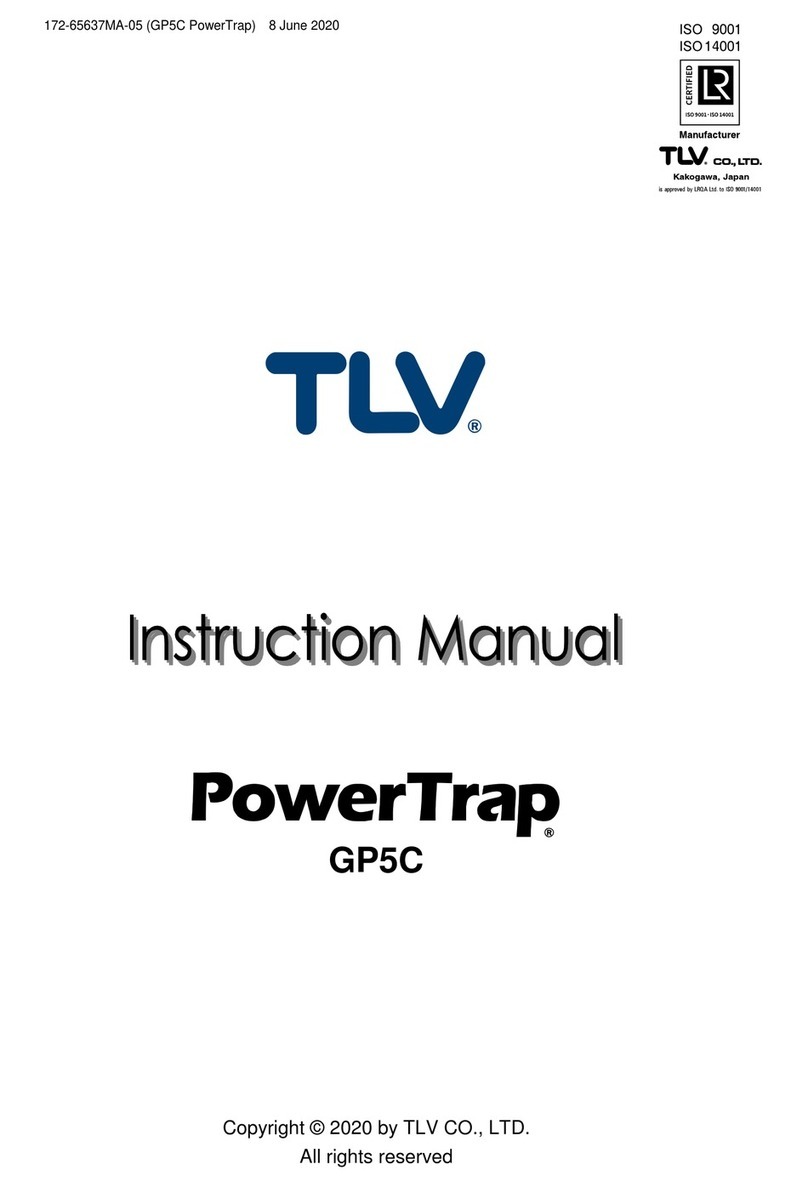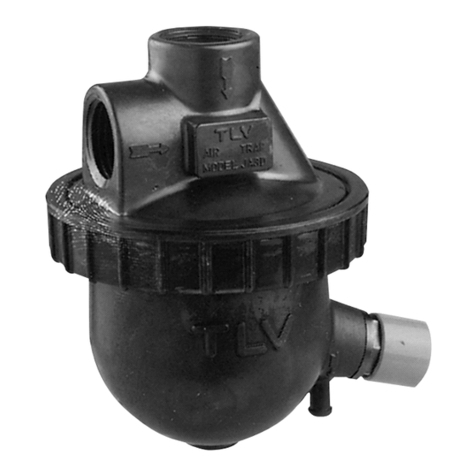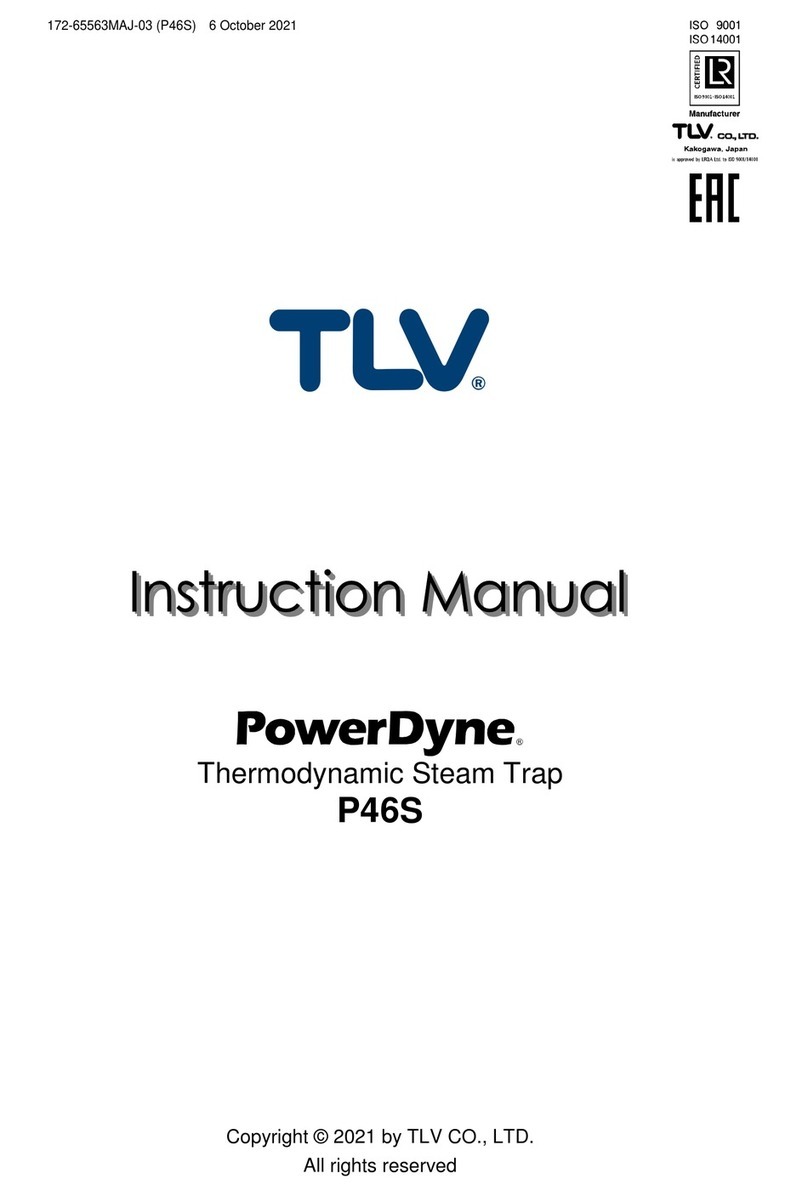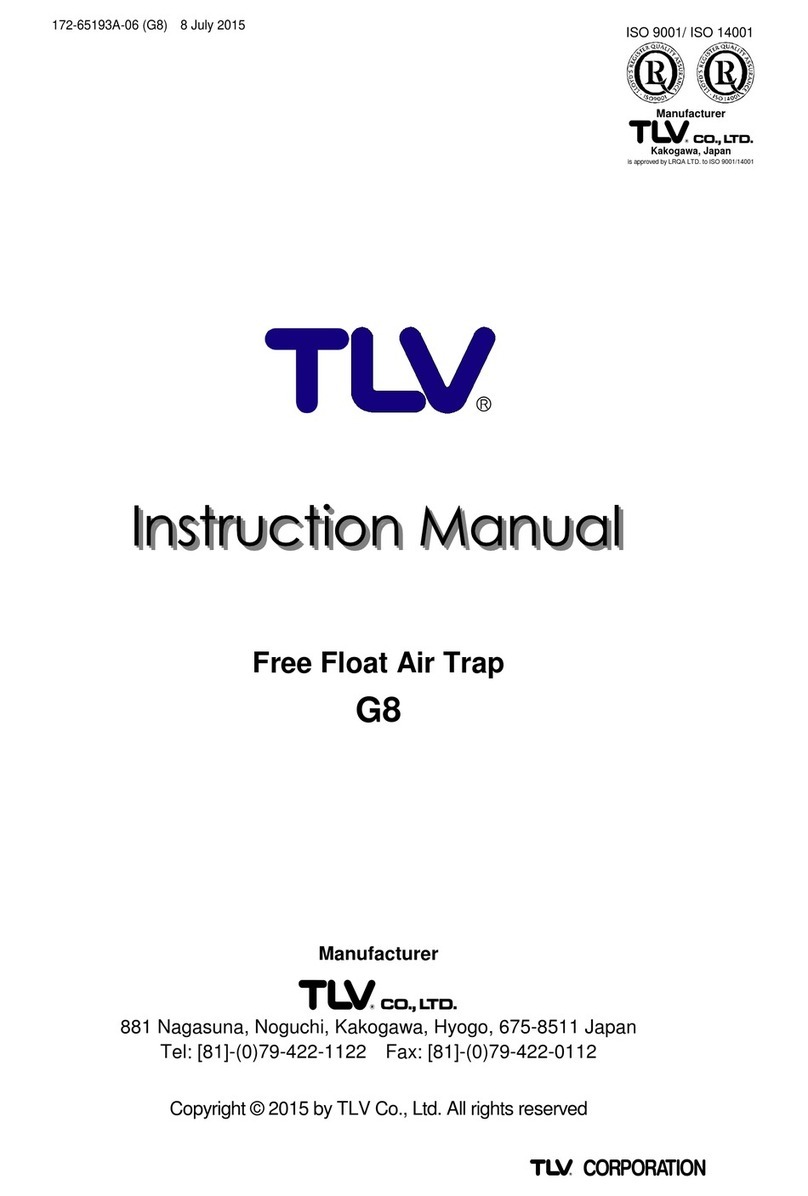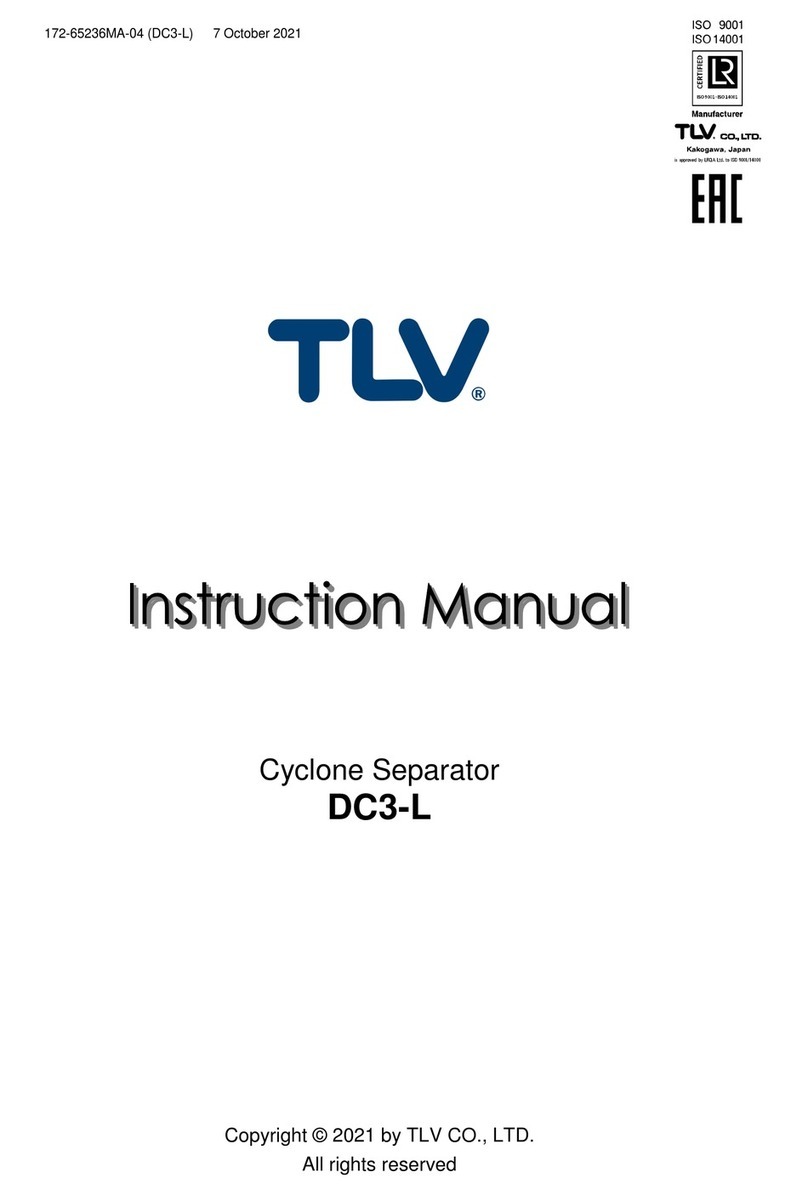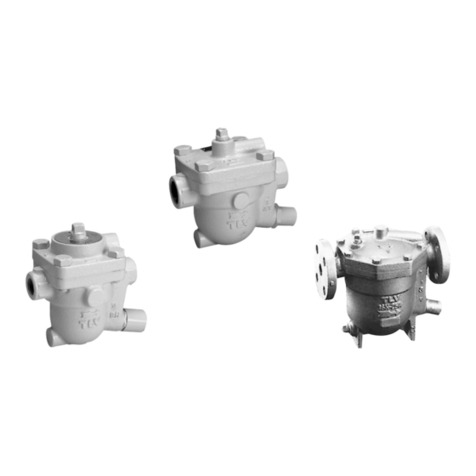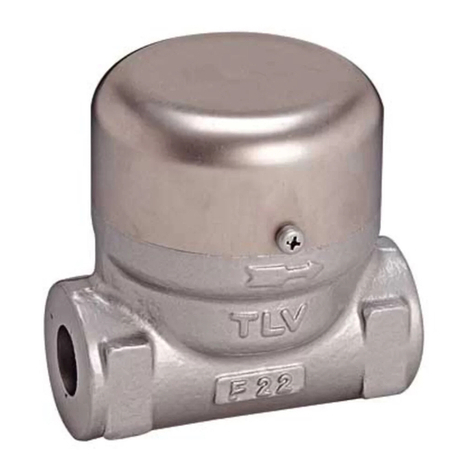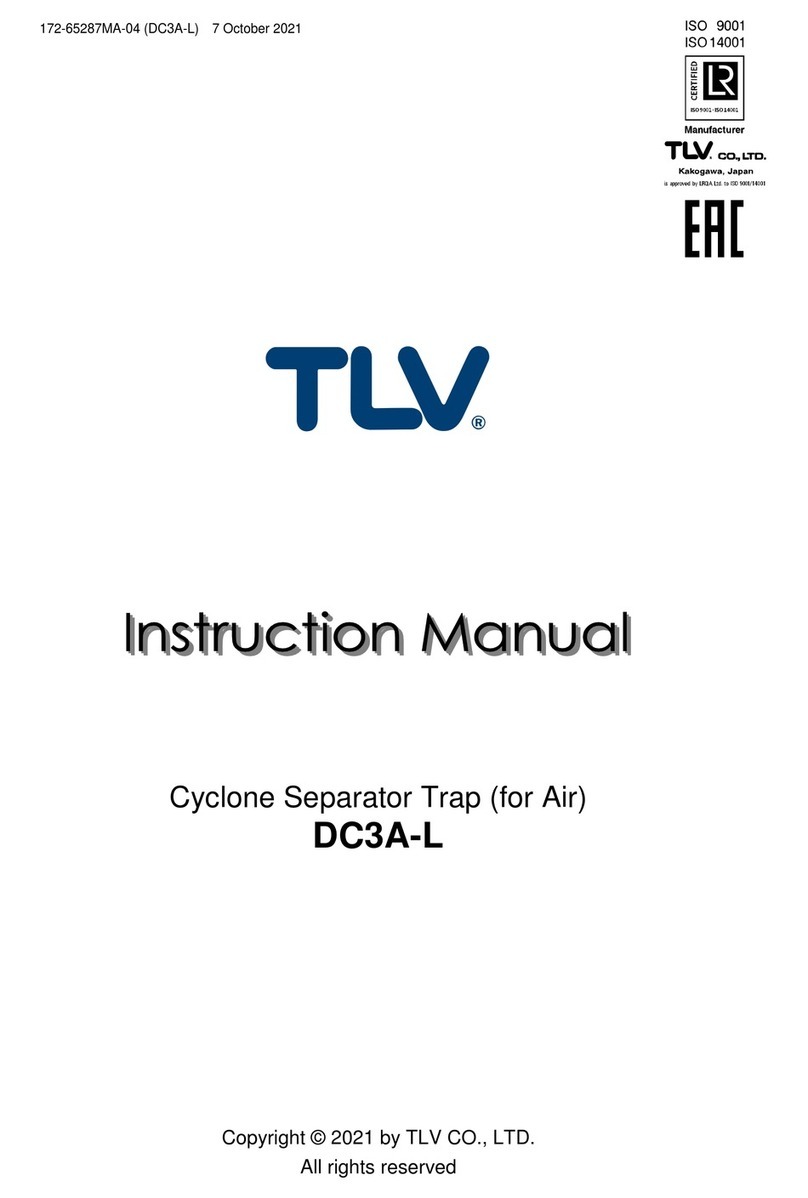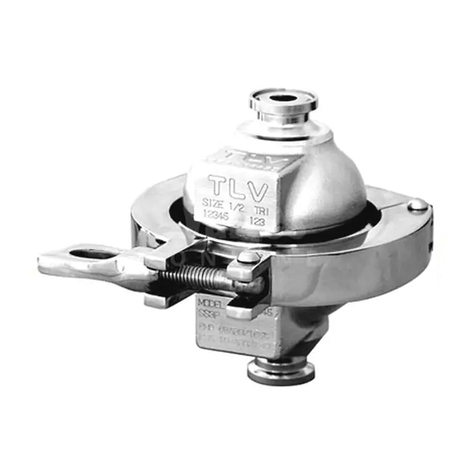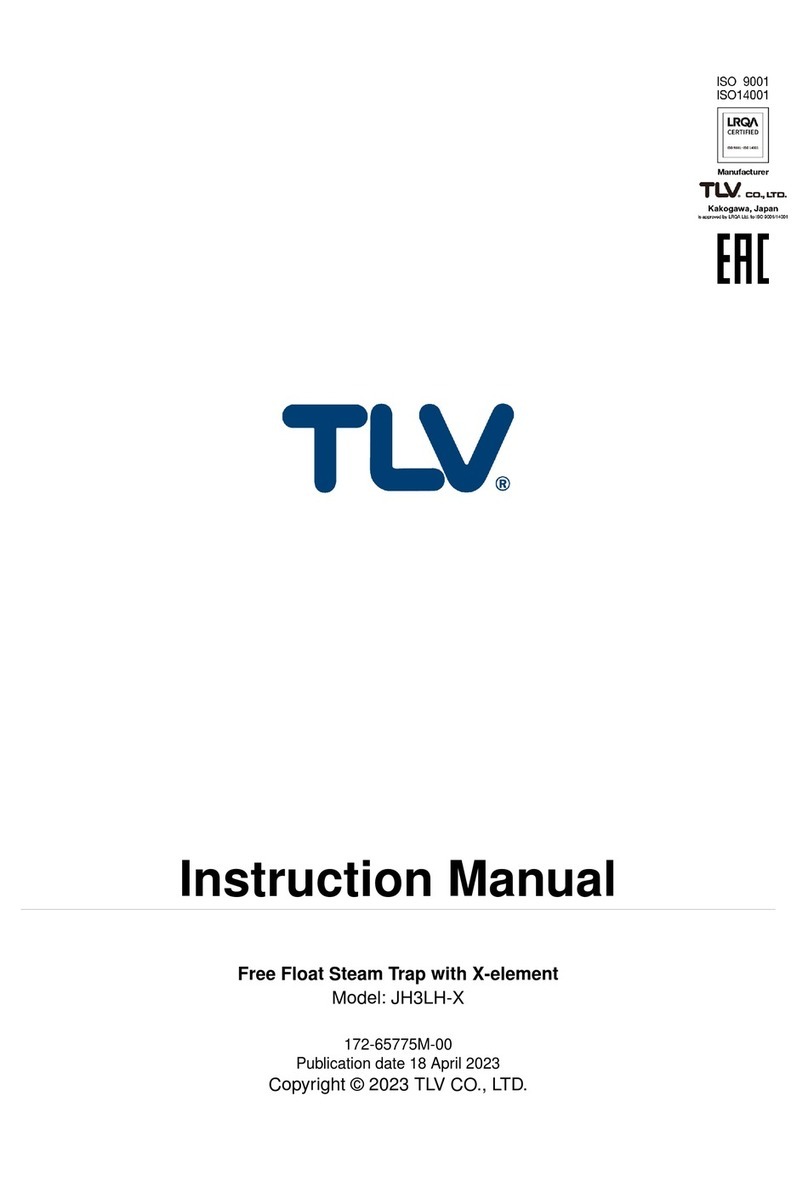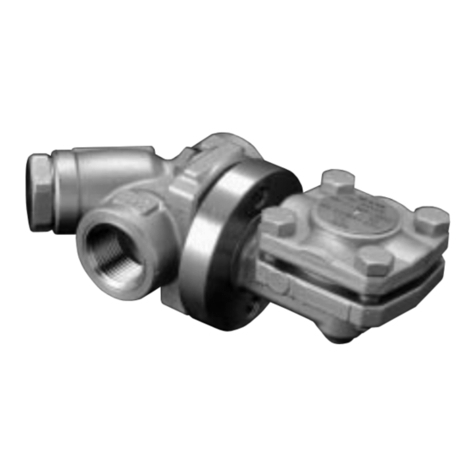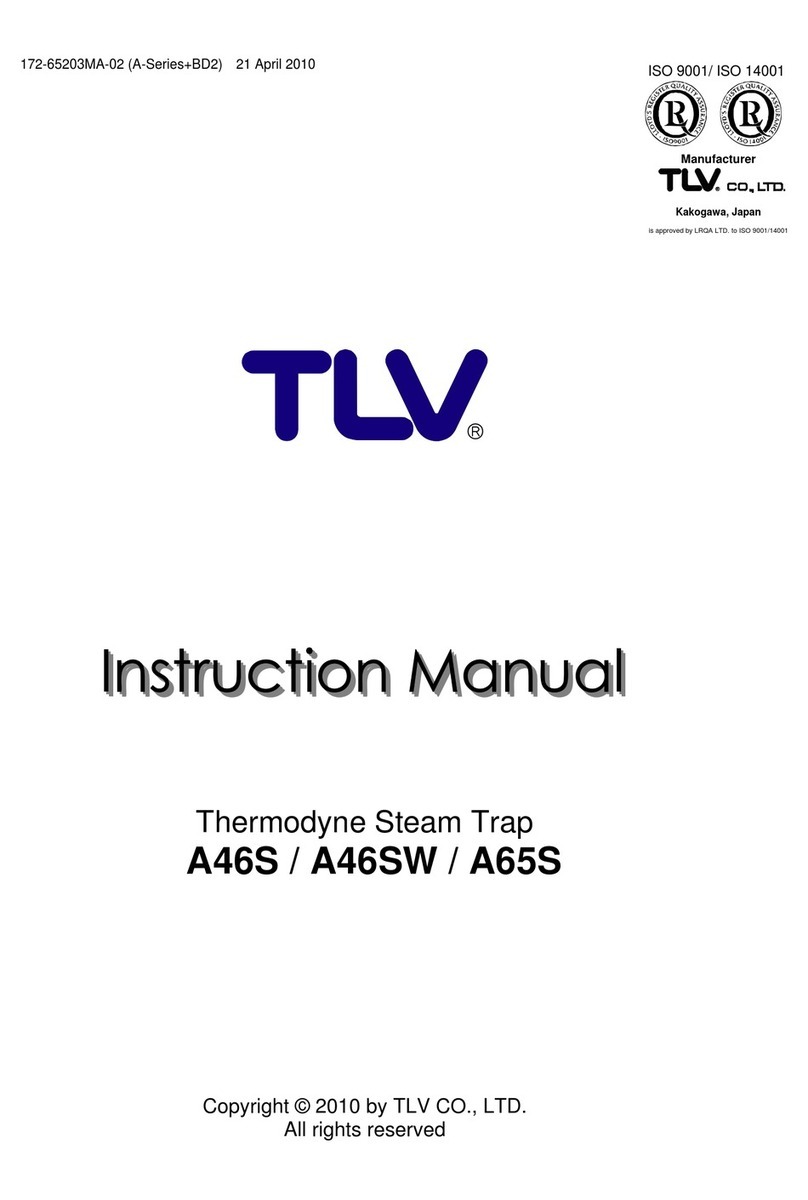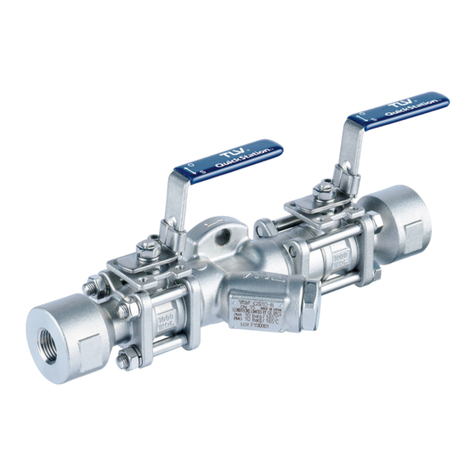TLV PowerDyne P46SRN User manual

172-65400MA-01 (P46SRN+BD2) 21 April 2010
Thermodyne Steam Trap
P46SRN
Copyright © 2010 by TLV CO., LTD.
All rights reserved
ISO 9001/ ISO 14001
Manufacturer
Kakogawa, Japan
is approved by LRQA LTD. to ISO 9001/14001

172-65400MA-01 (P46SRN+BD2) 21 Apr 2010
1
Contents
Introduction .......................................................................1
Safety Considerations.......................................................2
Checking the Piping..........................................................4
Operation ..........................................................................5
Specifications....................................................................6
Configuration.....................................................................6
Installation.........................................................................7
Maintenance......................................................................8
Disassembly / Reassembly...............................................9
Troubleshooting ..............................................................11
Product Warranty............................................................12
Options............................................................................13
Introduction
Thank you for purchasing the Thermodyne Steam Trap.
This product has been thoroughly inspected before being shipped from the
factory. When the product is delivered, before doing anything else, check the
specifications and external appearance to make sure nothing is out of the
ordinary. Also be sure to read this manual carefully before use and follow the
instructions to be sure of using the product properly.
The Thermodyne Steam Trap features a bimetal ring for thermostatic air
venting, which allows the quick, automatic discharge of large quantities of
initial air and cold condensate immediately after operation start-up, thereby
greatly reducing start-up time. It also reacts with great sensitivity to the inflow
of large quantities of condensate and hot air during operation, preventing air
binding.
The Thermodyne Steam Trap, with its superior features listed above, in
combination with the proven performance record of the bimetal thermostatic
air vent, increases heating efficiency and reduces manpower requirements for
maintenance and bypass blowdown.
If detailed instructions for special order specifications or options not contained
in this manual are required, please contact for full details.
This instruction manual is intended for use with the model(s) listed on the front
cover. It is necessary not only for installation but for subsequent maintenance,
disassembly/reassembly and troubleshooting. Please keep it in a safe place
for future reference.

172-65400MA-01 (P46SRN+BD2) 21 Apr 2010
2
Safety Considerations
• Read this section carefully before use and be sure to follow the instructions.
• Installation, inspection, maintenance, repairs, disassembly, adjustment, and valve
opening/closing should be carried out only by trained maintenance personnel.
• The precautions listed in this manual are designed to ensure safety and prevent
equipment damage and personal injury. For situations that may occur as a result
of erroneous handling, three different types of cautionary items are used to
indicate the degree of urgency and the scale of potential damage and danger:
DANGER, WARNING and CAUTION.
• The three types of cautionary items above are very important for safety: be sure to
observe all of them as they relate to installation, use, maintenance, and repair.
Furthermore, TLV accepts no responsibility for any accidents or damage occurring
as a result of failure to observe these precautions.
Symbols
Indicates a DANGER, WARNING or CAUTION item.
DANGE
R
Indicates an urgent situation which poses a threat of death or
serious injury
WARNING Indicates that there is a potential threat of death or serious injury
CAUTION Indicates that there is a possibility of injury or equipment /
product damage
CAUTION Install properly and DO NOT use this product outside the
recommended operating pressure, temperature and other
specification ranges.
Improper use may result in such hazards as damage to the product
or malfunctions that may lead to serious accidents. Local regulations
may restrict the use of this product to below the conditions quoted.
Take measures to prevent people from coming into direct
contact with product outlets.
Failure to do so may result in burns or other injury from the
discharge of fluids.
When disassembling or removing the product, wait until the
internal pressure equals atmospheric pressure and the surface
of the product has cooled to room temperature.
Disassembling or removing the product when it is hot or under
pressure may lead to discharge of fluids, causing burns, other
injuries or damage.
Be sure to use only the recommended components when
repairing the product, and NEVER attempt to modify the
product in any way.
Failure to observe these precautions may result in damage to the
product and burns or other injury due to malfunction or the
discharge of fluids. Safety considerations continued on next page.

172-65400MA-01 (P46SRN+BD2) 21 Apr 2010
3
CAUTION Use only under conditions in which no freeze-up will occur.
Freezing may damage the product, leading to fluid discharge, which
may cause burns or other injury.
Use only under conditions in which no water hammer will
occur.
The impact of water hammer may damage the product, leading to
fluid discharge, which may cause burns or other injury.

172-65400MA-01 (P46SRN+BD2) 21 Apr 2010
4
Checking the Piping
Use only under conditions in which no water hammer will occur. The
impact of water hammer may damage the product, leading to fluid
discharge, which may cause burns or other injury.
CAUTION
Check to make sure that the pipes to be connected to the trap have been installed
properly.
1. Is the pipe diameter suitable?
2. Has sufficient space been secured for maintenance?
3. Have isolation valves been installed at the inlet and outlet? If the outlet is subject
to back pressure, has a check valve (TLV-CK) been installed?
4. Is the inlet pipe as short as possible, with as few bends as possible, and installed
so the liquid will flow naturally down into the trap?
5. Has the piping work been done correctly, as shown in the figures below?
Requirement Correct Incorrect
Install catchpot with the
proper diameter.
Diameter is too small.
Make sure the flow of
condensate is not
obstructed.
Diameter is too small and
inlet protrudes into pipe
interior.
To prevent rust and scale
from flowing into the trap,
the inlet pipe should be
connected 25 – 50 mm (1
– 2 in) above the base of
the T-pipe.
Rust and scale flow into the
trap with the condensate.
When installing on the
blind end, make sure the
flow of condensate is not
obstructed.
Condensate collects in the
pipe.

172-65400MA-01 (P46SRN+BD2) 21 Apr 2010
5
Operation
Principle of Air and Condensate Discharge
1. Start-up: Discharge of Initial Air and Cold Condensate
At start-up, the bimetal air vent ring is cold and has therefore contracted, causing it to
ride up to the narrower area under the disc, thus lifting the disc off the seat and
holding the valve open. This allows for the rapid discharge of initial air and cold
condensate.
2. Steam Enters, Valve Closes
As the bimetal air vent ring is heated by the entering steam, it expands and slips
back down, freeing the disc. The rapid flow of steam creates a low-pressure area
under the disc. The pressure chamber above the disc retains its higher initial
pressure. This difference in the pressures above and below the disc pushes the disc
down against the valve seat, giving the closed valve a tight seal.
3. Condensate Discharge
When condensate enters the trap, the temperature in the pressure chamber drops
due to radiant heat loss, causing the steam to condense and the pressure to drop.
The inlet pressure then pushes up the disc, opening the valve and allowing
condensate to discharge. The bimetal air vent ring remains in its expanded, low
position state. When steam again enters the trap, the valve closes, as in step 2.
Cold
Condensat
Air
Pressure
Chamber
Steam
Condensate
Disc
Air Vent Ring

172-65400MA-01 (P46SRN+BD2) 21 Apr 2010
6
Specifications
Install properly and DO NOT use this product outside the recommended
operating pressure, temperature and other specification ranges.
Improper use may result in such hazards as damage to the product or
malfunctions which may lead to serious accidents. Local regulations
may restrict the use of this product to below the conditions quoted.
CAUTION
Use only under conditions in which no freeze-up will occur. Freezing
may damage the product, leading to fluid discharge, which may cause
burns or other injury.
CAUTION
Refer to the product nameplate for detailed specifications.
Maximum Allowable Back Pressure: 50% of the inlet pressure
* Maximum allowable pressure (PMA) and maximum allowable temperature (TMA) are PRESSURE
SHELL DESIGN CONDITIONS, NOT OPERATING CONDITIONS.
** Valve No. is displayed for products with options. This item is omitted from the nameplate when there
are no options.
Configuration
No. Name M* R*
1 Body
2 Valve Seat √
3 Cover √
4 Disc √
5 Disc Holder Ring √
6 Air Vent Ring √
7 Outer Module Gasket √√
8 Nameplate √
9 Inner Module Gasket √√
10 Screen
√
11 Screen Holder Gasket √√
12 Screen Holder
13 Cap
√
* Replacement parts are available only in
the following kits:
M = Maintenance kit
R = Repair kit
Maximum Allowable Pressure*
Nominal Diamete
r
Maximum Operating Pressure
Valve No.**
Model
Maximum Allowable Temperature*
Maximum Operating Temperature
Serial Number

172-65400MA-01 (P46SRN+BD2) 21 Apr 2010
7
Installation
Install properly and DO NOT use this product outside the recommended
operating pressure, temperature and other specification ranges.
Improper use may result in such hazards as damage to the product or
malfunctions which may lead to serious accidents. Local regulations
may restrict the use of this product to below the conditions quoted.
CAUTION
Take measures to prevent people from coming into direct contact with
product outlets. Failure to do so may result in burns or other injury from
the discharge of fluids.
CAUTION
Installation, inspection, maintenance, repairs, disassembly, adjustment and valve
opening/closing should be carried out only by trained maintenance personnel.
Note: For products with socket weld connections, electric weld with a single pass.
As internal parts are not damaged by the welding process if limited to a single
pass, there is no need to remove them before welding.
1. Before installing the product, open the inlet valve and blow out the piping to
remove any piping scraps, dirt and oil. Close the inlet valve after blowdown.
2. Before installation, be sure to remove all protective seals.
3. Install the product so that the arrow on the body is pointing in the direction of
flow.
4. The trap may be installed either horizontally or vertically; there are no restrictions
on the orientation of installation. (Fix the trap securely in place.)
5. Install a condensate outlet valve and outlet piping.
6. Open the inlet and outlet valves and check to make sure that the product
functions properly.
Note: Back pressure at the outlet side must not exceed 50% of the inlet pressure.
If there is a problem, determine the cause using the “Troubleshooting” section in this
manual.

172-65400MA-01 (P46SRN+BD2) 21 Apr 2010
8
Maintenance
Take measures to prevent people from coming into direct contact with
product outlets. Failure to do so may result in burns or other injury from
the discharge of fluids.
CAUTION
Be sure to use only the recommended components when repairing the
product, and NEVER attempt to modify the product in any way. Failure to
observe these precautions may result in damage to the product or burns
or other injury due to malfunction or the discharge of fluids.
CAUTION
Operational Check
A visual inspection of the following items should be done on a daily basis to
determine whether the trap is operating properly or has failed. Periodically (at least
biannually) the operation should also be checked by using diagnostic equipment,
such as a stethoscope, thermometer, TLV TrapMan or TLV Pocket TrapMan.
If the trap should fail, it may cause damage to piping and equipment, resulting in
faulty or low quality products or losses due to steam leakage.
Normal : Condensate is discharged intermittently together with flash steam,
and the sound of flow can be heard.
Blocked
(Discharge Impossible) : No condensate is discharged. The trap is quiet and makes no
noise, and the surface temperature of the trap is low.
Blowing : Live steam continually flows from the outlet and there is a
continuous metallic sound.
Steam Leakage : Live steam is discharged through the trap outlet together with
condensate, accompanied by a high-pitched sound.
(When conducting a visual inspection, flash steam is sometimes mistaken for steam
leakage. For this reason, the use of a steam trap diagnostic instrument [TLV: TrapMan] in
conjunction with the visual inspection is highly recommended.)
Parts Inspection
When parts have been removed, or during periodic inspections, use the following
table to inspect the parts and replace any that are found to be defective.
Procedure
Gaskets: Check for warping or scratches
Screen: Check for clogging or corrosion
Disc: Check for scratches or wear
Air Vent Ring: Check for scratches or wear
Disc Holder Ring: Check for scratches or wear
Modular Valve Seat Surface: Check for scratches or wear
Flash Steam Live Steam
White jet
containing
water droplets Clear, slightly
bluish jet

172-65400MA-01 (P46SRN+BD2) 21 Apr 2010
9
Disassembly / Reassembly
When disassembling or removing the product, wait until the internal
pressure equals atmospheric pressure and the surface of the product
has cooled to room temperature. Disassembling or removing the
product when it is hot or under pressure may lead to discharge of fluids,
causing burns, other injuries or damage.
CAUTION
Use the following procedures to remove components. Use the same procedures in
reverse to reassemble.
(Installation, inspection, maintenance, repairs, disassembly, adjustment and valve
opening/closing should be carried out only by trained maintenance personnel.)
Removing / Reattaching the Cap
Part During Disassembly During Reassembly
Cap Gently turn the cap to remove Being careful not to bend it, gently turn the cap to tighten
Removing / Reattaching the Cover and its Components (Valve Seat Unit)
Part During Disassembly During Reassembly
Cover Remove with a socket
wrench Consult the table of
tightening torques and
tighten to the proper torque
Disc Remove, being careful
not to scratch the lapped
surface
Make sure that the seat
surface (lapped side with
groove) is facing down,
toward the valve seat
Disc Holder
Ring Remove without bending Set on the air vent ring and
make sure that it does not
sit on the valve seat surface
Air Vent Ring Remove without
bending, as it will not
return to its proper
shape
Reinsert without bending
Module Valve
Seat Remove carefully, being
careful not to scratch the
polished seat surface
Insert into the body levelly,
being careful not to tilt it or
to scratch the seat surface
Outer Module
Gasket
Inner Module
Gasket
Remove with a
screwdriver, or other
suitable tool and clean
the gasket housing
Replace with a new gasket
if damaged
Disassembly / Reassembly of Components Inside the Body
Part During Disassembly During Reassembly
Screen Holder Remove with a socket
wrench Consult the table of tightening torques and
tighten to the proper torque
Screen Holder
Gasket Remove Replace with new gasket; coat surfaces with
anti-seize
Screen Remove without bending Reinsert without bending
Table of Tightening Torques
Torque Distance Across Flats
Part Name N⋅m (lbf⋅ft) mm (in)
Cover 250 (185) 46 (113⁄16)
Screen Holder 100 (73) 30 (13⁄16)
NOTE: - Coat all threaded portions with anti-seize. (1 N⋅m ≈10 kg⋅cm)
- If drawings or other special documentation were supplied for the product,
any torque given there takes precedence over values shown here.
Cove
r
Disc
Disc Holde
r
Ring
Module
Valve Seat
Air Vent
Ring
Inne
r
Module
Gasket
Oute
r
Module
Gasket

172-65400MA-01 (P46SRN+BD2) 21 Apr 2010
10
Body
Cap
Exploded View
Screen
Screen Holder Gasket
Screen Holde
r
Outer Module Gasket
Valve Seat Unit
Inner Module Gasket
Modular Valve Seat
Air Vent Ring
Disc Holder Ring
Disc
Nameplate
Cover

172-65400MA-01 (P46SRN+BD2) 21 Apr 2010
11
Troubleshooting
When disassembling or removing the product, wait until the internal
pressure equals atmospheric pressure and the surface of the product
has cooled to room temperature. Disassembling or removing the
product when it is hot or under pressure may lead to discharge of fluids,
causing burns, other injuries or damage.
CAUTION
When the product fails to operate properly, use the following table to locate and
remedy the cause.
Problem Cause Remedy
Module valve seat, screen or piping
are clogged with rust or scale Clean parts
Disc is stuck to the module valve seat Clean parts
Air binding has occurred Perform a bypass blowdown, or
close the trap inlet valve and
allow the trap to cool
Air binding due to disc holder ring or
air vent ring wear Replace with new disc holder
ring or air vent ring
Steam-locking has occurred Perform a bypass blowdown, or
close the trap inlet valve and
allow the trap to cool
No condensate
is discharged or
discharge is
poor
(blocked)
Trap operating pressure is below the
minimum specified pressure or there
is insufficient pressure differential
between the trap inlet and outlet
Compare specifications and
actual operating conditions
Rust or scale on the disc or on the
module valve seat Clean parts
Disc or module valve seat damage or
wear Replace with new disc or
module valve seat
Improper installation Correct the installation
Trap vibration Lengthen inlet piping and fasten
securely
Steam is
discharged or
leaks from the
outlet
(blowing)
(steam
leakage)
Trap operating pressure is less than
the minimum specified pressure or the
back pressure exceeds the allowable
back pressure
Compare specifications and
actual operating conditions
Gasket deterioration or damage Replace with new gasket(s)Steam is
leaking from a
place other
than the outlet
Improper tightening torques were
used Tighten to the proper torque
NOTE: When replacing parts with new, use the parts list for reference, and replace with parts from the
maintenance kit or repair kit. Please note that replacement parts are only available as part of a
replacement parts kit.

172-65400MA-01 (P46SRN+BD2) 21 Apr 2010
12
Product Warranty
1. Warranty Period
One year following product delivery.
2. Warranty Coverage
TLV CO., LTD. warrants this product to the original purchaser to be free
from defective materials and workmanship. Under this warranty, the
product will be repaired or replaced at our option, without charge for parts
or labor.
3. This product warranty will not apply to cosmetic defects, nor to any product
whose exterior has been damaged or defaced; nor does it apply in the
following cases:
1) Malfunctions due to improper installation, use, handling, etc., by other
than TLV CO., LTD. authorized service representatives.
2) Malfunctions due to dirt, scale, rust, etc.
3) Malfunctions due to improper disassembly and reassembly, or
inadequate inspection and maintenance by other than TLV CO., LTD.
authorized service representatives.
4) Malfunctions due to disasters or forces of nature.
5) Accidents or malfunctions due to any other cause beyond the control of
TLV CO., LTD.
4. Under no circumstances will TLV CO., LTD. be liable for consequential
economic loss damage or consequential damage to property.
* * * * * * *
For Service or Technical Assistance:
Contact your representative or your regional office.
Manufacturer
CO., LTD.
881 Nagasuna, Noguchi
Kakogawa, Hyogo 675-8511 JAPAN
Tel: 81-(0)79 - 427 – 1800

172-65400MA-01 (P46SRN+BD2) 21 Apr 2010
13
Options
When operating the blowdown valve, stand to the side well clear of the
outlet to avoid contact with internal fluids that will be discharged. Failure
to do so may result in burns or other injury.
CAUTION
Do not use excessive force when opening the blowdown valve. Such
force may break the pin equipped as a valve stopper pin, causing a
blowout from internal pressure resulting in burns or other injury.
CAUTION
With Blowdown Valve (TLV BD2)
Configuration
TLV Blowdown Valve: BD2
The BD2 Blowdown Valve, installed in the screen area of the body, uses the trap’s
internal pressure to blow any condensate, steam, dirt or scale accumulated around
the screen area out to atmosphere.
Discharge Hole
BD2 Valve
BD2 Valve Seat
(
Screen Holder
)
Screen Holder Gasket
Valve Stopper Pin
Screen

172-65400MA-01 (P46SRN+BD2) 21 Apr 2010
14
BD2 Blowdown Valve Operation
Install properly and DO NOT use this product outside the recommended
operating pressure, temperature and other specification ranges.
Improper use may result in such hazards as damage to the product or
malfunctions which may lead to serious accidents. Local regulations
may restrict the use of this product to below the conditions quoted.
CAUTION
Take measures to prevent people from coming into direct contact with
product outlets. Failure to do so may result in burns or other injury from
the discharge of fluids.
CAUTION
Do not use excessive force when connecting threaded pipes to the
product. Over-tightening may cause breakage leading to fluid
discharge, which may cause burns or other injury.
CAUTION
1. The BD2 valve is in the closed position when the BD2 is shipped from the factory.
Before attempting to operate the BD2, reconfirm that the BD2 valve is still in the
closed position. Locate the blow outlet and, during operation, stand to the side and
well clear of it, as the jet of condensate or steam could cause burns.
2. Remain in the area the entire time the BD2 valve is in the open position. Before
opening the BD2 valve, grip the BD2 valve seat with a wrench and hold firmly in
place so that it will not rotate when the BD2 valve is loosened. Grip the BD2 valve
with another wrench and slowly loosen. Condensate and steam will discharge from
the blow outlet in a jet stream. Be careful not to loosen the BD2 valve so far that it
becomes removed from the BD2 valve seat. (If the grooved pin becomes damaged,
large quantities of steam will be discharged in a jet stream.)
3. Close the BD2 valve until the flow of fluid completely stops. If the flow of fluid
does not stop, re-open the valve (as in step “2”) to blow out any scale or dirt that
may be caught in the valve. Re-tighten the valve until the flow of fluid stops
completely.
Tightening Torques and Distance Across Flats
Torque Distance Across Flats
Part N·m (lbf·ft) mm (in)
BD2 Valve 30 (22) 17 (21/32)
(1 N⋅m ≈10 kg⋅cm)
Note: Avoid the use of excessive tightening torques, as threaded parts may
become damaged.
Other manuals for PowerDyne P46SRN
1
Table of contents
Other TLV Industrial Equipment manuals



